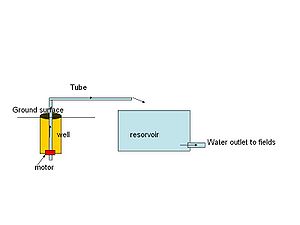
Tube well
Encyclopedia

Water well
A water well is an excavation or structure created in the ground by digging, driving, boring or drilling to access groundwater in underground aquifers. The well water is drawn by an electric submersible pump, a trash pump, a vertical turbine pump, a handpump or a mechanical pump...
in which a long 100–200 mm (5 to 8 inch) wide stainless steel tube or pipe is bored into the underground aquifer. The lower end is fitted with a strainer, and a pump at the top lifts water for irrigation. The required depth of the well depends on the depth of the water table
Water table
The water table is the level at which the submarine pressure is far from atmospheric pressure. It may be conveniently visualized as the 'surface' of the subsurface materials that are saturated with groundwater in a given vicinity. However, saturated conditions may extend above the water table as...
.

Temporary reservoir
In the villages of India (especially Punjab) and Pakistan, a small reservoir of water is made at the outlet of the tube well. This reservoir is used for bathing and recreational purposes, especially by children. In most South Asian countries including India, Pakistan, Bangladesh, etc., taking a bath in the tube well is popular as it allows people to avoid paying for their own electricity and water for a bath. Bathing in tube well reservoirs can lead to illness.Because children often urinate in the reservoir, the irrigation water may contain urine.
Drive mechanism
In the past, the pump was driven by large diesel engines. However, now electric motors are being used, as they are a much cheaper source of power.Casing
The tube well casing houses the inlet, cylinder, piston valves and rising main of a "down-the-hole" type handpump. Casing to support the external surfaces of the borehole against collapse may be needed, either temporarily or permanently, and is often made of PVC pipe, which is both cheap and inert.Seepage down the tube well bore is prevented by the sanitary seal. Seepage from the ground above the aquifer is excluded by the lengths of plain casing. Water to be pumped is admitted through slots in the lower lengths of casing.
Water abstracted from aquifers in relatively soft ground usually contains sand or silt particles, which are liable to cause rapid wear to pump valves and cylinders (and dissatisfaction among consumers). Methods of preventing these particles from reaching the pump are of two general types, screening and sand/gravel packing.

